Trees for Life - Volunteer Work Week
Added on Thursday 17 Jan 2008
One of my best adventures of 2007 was our Trees for Life - volunteer work week. In the late spring of last year (before the midges descend) Davy and I went on aTrees for Life- volunteer work week to Glen Moriston. This was our second adventure with the "Trees for Life". I choose Glen Moriston as I am a bit of a softie and the accommodation at Invermoriston Holiday Chalets is lovely and cosy!! (Other locations and accommodation maybe more dramatic and I hope to go there too - one day!).
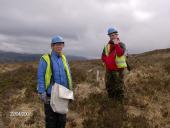 Having read in a copy of the Big Issue about the work of the "Trees for Life" charity and the volunteer work weeks I thought that it sounded a fantastic opportunity to contribute to the restoration of the Ancient Scottish Caledonian Pine Forest . I wasn't disappointed! I can't claim to be that environmentally aware, (I try and do what I can, recycle etc) however Davy and I used to live in the Highlands and went for walks in the beautiful Glen Affric. The thought of this magnificent area as dying forest deeply concerned me and
I don't want to get all theoretical but a wee bit of background will help you understand my passion for this project.
Having read in a copy of the Big Issue about the work of the "Trees for Life" charity and the volunteer work weeks I thought that it sounded a fantastic opportunity to contribute to the restoration of the Ancient Scottish Caledonian Pine Forest . I wasn't disappointed! I can't claim to be that environmentally aware, (I try and do what I can, recycle etc) however Davy and I used to live in the Highlands and went for walks in the beautiful Glen Affric. The thought of this magnificent area as dying forest deeply concerned me and
I don't want to get all theoretical but a wee bit of background will help you understand my passion for this project.
When you observe the Scottish Hills, like me you may think that the rugged, barren landscape is typical of the Scottish Highlands. Well, I have learned that this is not the case!! We should be able to look up and see natural forest dotting the skyline not bare rock! The great forest of Caledon once covered over 1.5 million hectares of the Scottish Highlands, and was home to a rich assemblage of plants and animals.
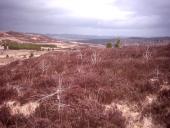 The forest ran from the Highlands through to Loch Lomond and has been depleted over hundreds of years due to a number of key historical and economic events. These include the Highland Clearances and the introduction of sheep farming, the intensive planting by the Forestry Commission for quicker growing tress to build ships during the war years and as commercial lumber. All of this has had a major impact on our native Scottish natural woodlands. Today just 1% of the forest remains. The surviving remnants of the forest are ageing and fragmented, and because of overgrazing, the trees are struggling to regenerate naturally.
Fortunately we learned that the priorities of the Forestry Commission have now changed and they are carrying out a great deal of excellent work to reverse the situation, and are protecting and restoring native woodlands on a large scale, as well as increasing the diversity within plantations.
The forest ran from the Highlands through to Loch Lomond and has been depleted over hundreds of years due to a number of key historical and economic events. These include the Highland Clearances and the introduction of sheep farming, the intensive planting by the Forestry Commission for quicker growing tress to build ships during the war years and as commercial lumber. All of this has had a major impact on our native Scottish natural woodlands. Today just 1% of the forest remains. The surviving remnants of the forest are ageing and fragmented, and because of overgrazing, the trees are struggling to regenerate naturally.
Fortunately we learned that the priorities of the Forestry Commission have now changed and they are carrying out a great deal of excellent work to reverse the situation, and are protecting and restoring native woodlands on a large scale, as well as increasing the diversity within plantations.
So what happens on a volunteer work week. Normally, a group of ten volunteers makes up a work week. People of all ages, backgrounds and from all parts of the UK and beyond. Volunteers are supported by Trees for Life staff (Focalisers) who are extremely knowledgeable about the Forest and its wildlife.
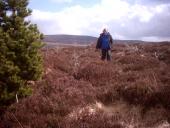 During the week we discover that we are there for all sorts of reasons however we all have one thing in common, contributing to restoring the great forest. Some of the things I like best about the work week are working together as a group, sharing in the preparation of meals and planning the work out on the hills. And of course, the hills themselves, unbelievable countryside, views and weather. Living in the city as we do, it is fantastic to be out in the open, high up in the Scottish Highlands and actually experiencing weather! One day it can be lovely sunshine, the next cold, wet and a howling gale. "Trees for Life" have a mini bus that gets us to our planting location so although the walking can be a bit rough it is not too difficult. If I can do it anybody can! This year I did notice that the younger volunteers were a lot faster than me in getting across the countryside. However everyone waits so we get there in the end.
During the week we discover that we are there for all sorts of reasons however we all have one thing in common, contributing to restoring the great forest. Some of the things I like best about the work week are working together as a group, sharing in the preparation of meals and planning the work out on the hills. And of course, the hills themselves, unbelievable countryside, views and weather. Living in the city as we do, it is fantastic to be out in the open, high up in the Scottish Highlands and actually experiencing weather! One day it can be lovely sunshine, the next cold, wet and a howling gale. "Trees for Life" have a mini bus that gets us to our planting location so although the walking can be a bit rough it is not too difficult. If I can do it anybody can! This year I did notice that the younger volunteers were a lot faster than me in getting across the countryside. However everyone waits so we get there in the end.
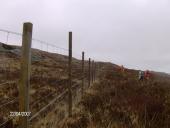 This year we had a target of 3000 trees to plant and we spent at least four days out in the hills tree planting. Wee baby ones (technical term you know) varieties such as Hazel, Birch and Aspen. It was so lovely to see the wee Hazels bursting from the nut. I patted each one in and wished it a strong and healthy life. Of course we also planted some baby Scots Pine trees which I dedicate to my girls.
This year we had a target of 3000 trees to plant and we spent at least four days out in the hills tree planting. Wee baby ones (technical term you know) varieties such as Hazel, Birch and Aspen. It was so lovely to see the wee Hazels bursting from the nut. I patted each one in and wished it a strong and healthy life. Of course we also planted some baby Scots Pine trees which I dedicate to my girls.
Planting the Aspens was great fun. Seemingly Aspen is a "deer delicacy" and they prefer these over Birch or Hazel. In order to protect them and give them a head start we built this huge stockade of fallen trees with jaggy branches to keep the deer out. By the time we had finished it must have been over five feet!
By the end of the week we had met our planting target and then some. Planting is a group activity and everyone helps each other. It is also a great time to chat and get to know one another. This year we had great fun discussing with an English co- planters what a "piece" was and what you could put in a "piece"!
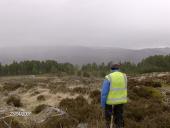 Another task of the work week is removing Deer Fencing. The fence where we were working stretched for miles across the hill side. Birds such as the rare Black Grouse can often strike the fence and get injured. By removing the fence it assists in restoring the environment and helps protects the wild life. Removing the fence is hard work but it was amazing to see the countryside open up as we rolled up metre upon metre of fencing. This year I even developed the technique of getting out the standing posts. No easy feat!
Another task of the work week is removing Deer Fencing. The fence where we were working stretched for miles across the hill side. Birds such as the rare Black Grouse can often strike the fence and get injured. By removing the fence it assists in restoring the environment and helps protects the wild life. Removing the fence is hard work but it was amazing to see the countryside open up as we rolled up metre upon metre of fencing. This year I even developed the technique of getting out the standing posts. No easy feat!
During our time out on the hills everything is observed! Wild flowers, Black Grouse poo (seen more than the birds themselves), an Osprey soaring high in the sky. The Trees for Life staff team are very knowledgeable and can provide a good insight into the environment. They are also a bit mad with a hint of the Ray Mears about them. Can somebody please tell me why men have to "play" with knives!
Of course not all work week is about tree planting. Getting to know the other volunteers is a all part of it. It is great to hear that the work week is the beginning of a "Year out" travelling for some or a "big" birthday adventure another. For me it is my chance to do what I can for the future of the planet and to be part of a much bigger project to restore the great forest of Caledon. It is something that I can feel good about. I hope that you like the photos of this inspirational area. Trees for Life can be contacted at www.treesforlife.org.uk
The Fossil Grove
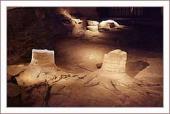 Did you know that in our own city we have an ancient tree attraction? In the Fossil Grove situated in the Victoria Park in the west of the city across the road from where I stay! The fossil trees, which were uncovered by removal of the surrounding rocks, are the remains of an ancient forest, around 330 million years old. Scottish Natural Heritage has designated the grove a site of Special Scientific Interest.
Did you know that in our own city we have an ancient tree attraction? In the Fossil Grove situated in the Victoria Park in the west of the city across the road from where I stay! The fossil trees, which were uncovered by removal of the surrounding rocks, are the remains of an ancient forest, around 330 million years old. Scottish Natural Heritage has designated the grove a site of Special Scientific Interest.
These fossilised tree stumps were discovered in 1887 when an old quarry was being landscaped as part of the work during the creation of the park. Careful excavation of the site uncovered the fossil remains, and a building was erected to protect them from the elements. You will see a small corner of a vast ancient forest, preserved in stone.
Eleven tree stumps, some of them up to 90 centimetres high, have been preserved in the position in which they once grew. There is also a fallen trunk, aroud eight metres long along with fragments of branches and roots, which have alsos survived. The fossils are the remains of an extinct plant known as the giant clubmoss.
There is balcony overlooking the fossils and small displays, which provide information and interpret the site for visitors. Unfortunately due to Council funding problems the Fossil Grove now only has very limited opening times. If you are interested in seeing this unique attraction I advise you to contact the Council first to check when The Fossil Grove is open to avoid disappointment.
www.glasgowwestend.co.uk/out/galleries/fossilgv.html







